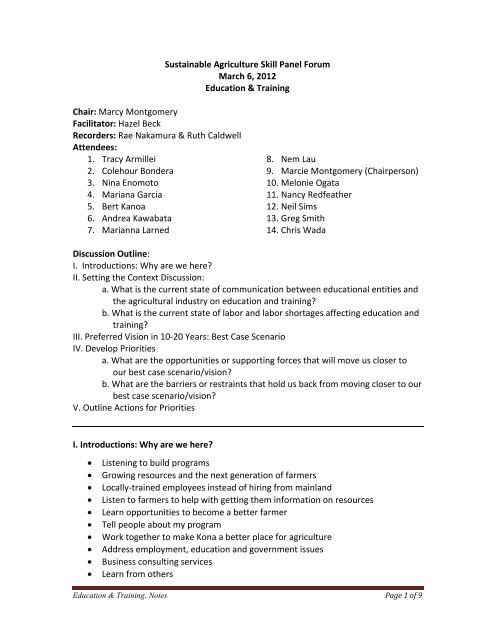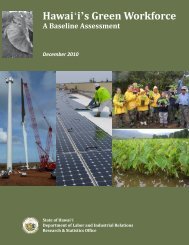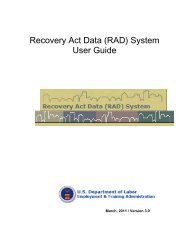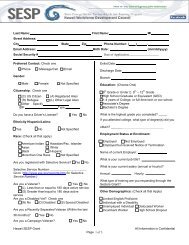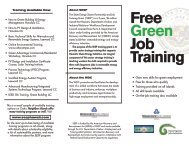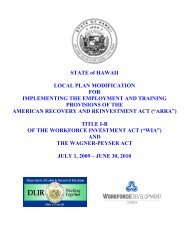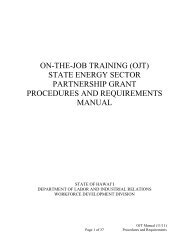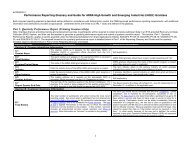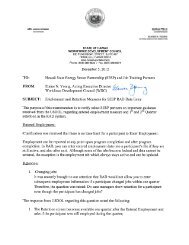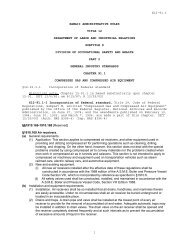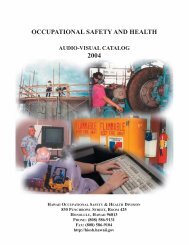Education and Training Discussion Notes
Education and Training Discussion Notes
Education and Training Discussion Notes
Create successful ePaper yourself
Turn your PDF publications into a flip-book with our unique Google optimized e-Paper software.
Chair: Marcy Montgomery<br />
Facilitator: Hazel Beck<br />
Recorders: Rae Nakamura & Ruth Caldwell<br />
Attendees:<br />
1. Tracy Armillei<br />
2. Colehour Bondera<br />
3. Nina Enomoto<br />
4. Mariana Garcia<br />
5. Bert Kanoa<br />
6. Andrea Kawabata<br />
7. Marianna Larned<br />
Sustainable Agriculture Skill Panel Forum<br />
March 6, 2012<br />
<strong>Education</strong> & <strong>Training</strong><br />
8. Nem Lau<br />
9. Marcie Montgomery (Chairperson)<br />
10. Melonie Ogata<br />
11. Nancy Redfeather<br />
12. Neil Sims<br />
13. Greg Smith<br />
14. Chris Wada<br />
<strong>Discussion</strong> Outline:<br />
I. Introductions: Why are we here?<br />
II. Setting the Context <strong>Discussion</strong>:<br />
a. What is the current state of communication between educational entities <strong>and</strong><br />
the agricultural industry on education <strong>and</strong> training?<br />
b. What is the current state of labor <strong>and</strong> labor shortages affecting education <strong>and</strong><br />
training?<br />
III. Preferred Vision in 10‐20 Years: Best Case Scenario<br />
IV. Develop Priorities<br />
a. What are the opportunities or supporting forces that will move us closer to<br />
our best case scenario/vision?<br />
b. What are the barriers or restraints that hold us back from moving closer to our<br />
best case scenario/vision?<br />
V. Outline Actions for Priorities<br />
I. Introductions: Why are we here?<br />
• Listening to build programs<br />
• Growing resources <strong>and</strong> the next generation of farmers<br />
• Locally‐trained employees instead of hiring from mainl<strong>and</strong><br />
• Listen to farmers to help with getting them information on resources<br />
• Learn opportunities to become a better farmer<br />
• Tell people about my program<br />
• Work together to make Kona a better place for agriculture<br />
• Address employment, education <strong>and</strong> government issues<br />
• Business consulting services<br />
• Learn from others<br />
<strong>Education</strong> & <strong>Training</strong>, <strong>Notes</strong> Page 1 of 9
• Connect with farmers to help students gain h<strong>and</strong>s‐on experience<br />
• Listen <strong>and</strong> learn about industry concerns<br />
• Learn what’s currently happening with ag in schools<br />
• Discover types of Adult <strong>Education</strong> leading to ag jobs<br />
• Gain information to help build CTE pathways<br />
• Educating farmers <strong>and</strong> public about sustainability<br />
• Discover resources available for students<br />
II. Setting the Context <strong>Discussion</strong>:<br />
What is the current state of communication between educational entities <strong>and</strong> the<br />
agricultural industry on education <strong>and</strong> training?<br />
• Minimal dialogue <strong>and</strong> communication between agencies<br />
o Lack of info for farms from government agencies<br />
o Disconnect between grocers <strong>and</strong> food purchasers for local products<br />
o Lack of marketing for local products<br />
• Limited funding <strong>and</strong> marketing for workshops with the extension service<br />
• H<strong>and</strong>s‐on working farms with real communication<br />
• Diversity of topics ‐ ex. Pruning<br />
• Government agencies need to help more with small farms<br />
• Trying to teach kids where food comes from ‐ sustainability<br />
• Focus on food self‐reliance but no support for programs; maybe no<br />
communication yet<br />
• Creating a stage at this panel; maybe this could become a quarterly forum<br />
with an isl<strong>and</strong>‐based planning commission<br />
• UH <strong>and</strong> State lack communication with aquaculture<br />
• Pathway Advisory Council of educators <strong>and</strong> industry exists for CTE <strong>and</strong> similar<br />
council for community colleges<br />
• Local ag wisdom exists but there is a lack of knowledge of current resources<br />
• Not enough h<strong>and</strong>s‐on training; to create local farmers we need local small<br />
farms to teach local people instead of classrooms<br />
• Need more local “WWOOFers” (World Wide Opportunities on Organic Farms)<br />
instead of so many mainl<strong>and</strong> <strong>and</strong> foreign ones<br />
• Many meetings like this have occurred over the past few decades, but this is<br />
the first where all the needed entities are at the table for the discussion<br />
• There is a new government vision toward ag sustainability, but we're still<br />
lacking the communication needed for success<br />
• No Child Left Behind Act has hindered ag education in schools. Now we<br />
need more support for h<strong>and</strong>s‐on career <strong>and</strong> technical education instead<br />
• Vocational arts programs are lacking compared to the past when ag was<br />
physically taught <strong>and</strong> followed by classroom training<br />
• UH Manoa has dropped their young farmer training program (so we won’t<br />
<strong>Education</strong> & <strong>Training</strong>, <strong>Notes</strong> Page 2 of 9
have young farmers until UH puts out what farmers need)<br />
• Small successes have occurred such as a National Small Farmer Lobbyist<br />
speaking to a local school because of a student finding them for Mentoring<br />
Day<br />
• Moving toward teaching ag at younger age but still lacking a continual vein or<br />
pathway from K‐12+<br />
• Natural Resource CTE Pathway teaching force is decreasing<br />
• Focus moving away from CTE towards STEM instead<br />
• Lacking h<strong>and</strong>s‐on Math <strong>and</strong> Science training in ag field in schools<br />
• Lack of clarity on farming education<br />
• Lack of cross‐pollination of ideas between East <strong>and</strong> West Hawaii<br />
• No required service learning at DOE, which has been successful at other<br />
schools nationwide<br />
• Image problem: “Farmers don’t make money”<br />
• Youth don’t want to wake up early <strong>and</strong> be sweaty first thing in the morning<br />
to take ag classes<br />
• Youth don’t like the hard physical labor<br />
• Need to quit saying “farmers don’t make money” because farming is a<br />
business <strong>and</strong> there is money to be made<br />
• Lots of passion<br />
• Dynamics are changing<br />
• Including more kids with different visions<br />
• Need a focused, parallel vision to move forward<br />
• Negative image about farming<br />
• Educators don’t support farming as a career path (i.e. “If you don’t learn this<br />
concept, you’ll have to be a farmer.”)<br />
• UH <strong>and</strong> Community Colleges are where most get their fundamental skills<br />
• May not be enough l<strong>and</strong> for farming<br />
• Need a st<strong>and</strong>ard definition for farming<br />
• Lack of communication between farmers <strong>and</strong> DOE teachers<br />
• Lack of communication in what kind of training there needs to be (see<br />
successful models)<br />
What is the current state of labor <strong>and</strong> labor shortages affecting education <strong>and</strong><br />
training?<br />
• The education seat is in Hilo, but most farms are isl<strong>and</strong>‐wide so it’s difficult<br />
for college students to learn <strong>and</strong> work to get experience at the same time<br />
• Farmers can’t live on wages due to high cost of living<br />
• Disconnect between those who will take ag jobs <strong>and</strong> farmers who can train<br />
them<br />
• Lack of local stores, like “Trader Joe's”, to sell local produce <strong>and</strong> value‐added<br />
products<br />
<strong>Education</strong> & <strong>Training</strong>, <strong>Notes</strong> Page 3 of 9
• Lack of marketing for local produce <strong>and</strong> value‐added products<br />
• Low dem<strong>and</strong> for local products<br />
• Cheaper to sell products to mainl<strong>and</strong> for processing/packaging <strong>and</strong> have<br />
shipped back here than it is to process locally because our state lacks<br />
processing technology<br />
• Few local “WWOOFers"<br />
• Lack of training funds for local farmers<br />
• Lack of reaching out to the people to help farmers <strong>and</strong> teaching people how<br />
to farm<br />
• Local farmers not able to sell to many restaurants here (limited)<br />
• Poor market for local products. If products brought in enough money then<br />
farmers could pay for more labor <strong>and</strong> make more products to lower the cost<br />
of local products.<br />
• High cost of processing local products needs to be reduced (like processing<br />
beef) or else must keep shipping to mainl<strong>and</strong><br />
III. Preferred Vision in 10‐20 Years: Best Case Scenario<br />
10‐20 years from now, from a workforce development perspective, what is the best<br />
case scenario for assuring vibrant education <strong>and</strong> training for the agriculture<br />
workforce?<br />
• Funds <strong>and</strong> l<strong>and</strong> are accessible to farms<br />
• <strong>Training</strong> available on taxes <strong>and</strong> business aspects of farming<br />
• More small‐scale farm schools around isl<strong>and</strong> with teachers for 1‐year programs<br />
• Farm‐to‐school program in state<br />
• Institutional buy‐in<br />
• “Food HUB” on‐line site connecting labor, farmers, chefs, retail, etc.<br />
• Community connected with CSAs (Community Supported Agriculture)<br />
• Established vision for youth that shows bigger picture of the isl<strong>and</strong>’s attributes<br />
• The isl<strong>and</strong> becomes, <strong>and</strong> is marketed as, a world‐wide model for ag sustainability<br />
• Streamlined bureaucracy (i.e., schools can eat food grown locally <strong>and</strong> in school<br />
gardens)<br />
• More people eating locally will cause financial jump to make growing local food<br />
sustainable <strong>and</strong> profitable<br />
• Hawaii has created a new market for local products instead of trying to grow<br />
products often marketed globally that compete with global products (i.e., grow<br />
<strong>and</strong> market uses for taro rather than trying to grow iceberg lettuce in Hawaii<br />
which is already grown many other places)<br />
• There is a place to market products <strong>and</strong> funding for shared certified kitchens<br />
• On‐line web‐based software technology that maps products <strong>and</strong> trading harvest<br />
available on isl<strong>and</strong> <strong>and</strong> can locate laborers <strong>and</strong> markets<br />
• On‐line classroom can reach people from all over but targets locals<br />
<strong>Education</strong> & <strong>Training</strong>, <strong>Notes</strong> Page 4 of 9
• Certified kitchen allows farmers to sell their value‐added products anywhere<br />
• Coordinated ag pathway from K‐16<br />
• Institutional buy‐in with streamlined bureaucracy<br />
• Young farmer training programs exist for new farmers<br />
• Using soil from compost<br />
• Sharing local resources through an online website<br />
• People are educated about defined green initiatives<br />
• Effective public transportation exists<br />
• Youth have vision <strong>and</strong> see the unified ag picture<br />
• Isl<strong>and</strong> marketed for sustainability<br />
• People change their diet <strong>and</strong> lives to be able to eat <strong>and</strong> support local food<br />
• Community colleges <strong>and</strong> NELHA work together to become a world leader in<br />
aquaculture<br />
• Teacher training coordinated throughout the isl<strong>and</strong><br />
• Ag research is promoted <strong>and</strong> supported<br />
• 50% of all food grown in Hawaii<br />
• Community support <strong>and</strong> volunteers to help with Natural Resource pathways<br />
teachers<br />
• More designated ag l<strong>and</strong><br />
• More education for government entities <strong>and</strong> other agencies<br />
• Resources are accessible so more farmers know legitimate ways to farm <strong>and</strong> sell<br />
products<br />
• Ag curriculum has been redone to introduce Science, Technology <strong>and</strong> Math<br />
• Marketing <strong>and</strong> processing co‐ops are located throughout isl<strong>and</strong><br />
• Consumers are educated<br />
IV. Develop Priorities<br />
What are the opportunities or supporting forces that will move us closer to our<br />
best case scenario/vision?<br />
Future Farmers (8 votes)<br />
• Tap into CTE pathways for students in high school to do community<br />
projects with farmers<br />
• Form student/farmer collaborations<br />
• Do a needs assessment with farmers on which age group small farms<br />
want to work with <strong>and</strong> ask students what type of ag they want to learn<br />
about so students can be more involved in choosing their own path <strong>and</strong><br />
being involved in their own education<br />
• Gain teacher buy‐in <strong>and</strong> support<br />
• Push community service ag projects at a younger age<br />
• Schools should grow their own food<br />
<strong>Education</strong> & <strong>Training</strong>, <strong>Notes</strong> Page 5 of 9
• Teachers need ag education <strong>and</strong> professional development (i.e., for on‐<br />
campus gardens, ag programs, etc.)<br />
• Find ways to incentivize ag to youth <strong>and</strong> incentivize farmers training<br />
youth<br />
• Don’t reinvent the wheel. Find current schools with great consumer<br />
learning programs <strong>and</strong> replicate it in other areas (i.e., recycling,<br />
gardening programs, etc.)<br />
• Offer youth paid internships <strong>and</strong> incentivize mentoring for farmers<br />
• We should view the transition from No Child Left Behind to Race to the<br />
Top as a way to engage students in real h<strong>and</strong>s‐on problem solving<br />
projects<br />
Community Collaboration (8 votes)<br />
• International marketplace also lets farmers use equipment<br />
• Working with different parts of the community to collaborate<br />
• Need to identify who the local farm leaders are <strong>and</strong> find ways to get<br />
them more active <strong>and</strong> plug them in<br />
• Find ways to unite community segments (like through one‐on‐one<br />
appointments with farmers at their farm or with clusters of farmers in a<br />
community to discuss resources with local community groups)<br />
Funding <strong>and</strong> Finance (7 votes)<br />
• Lau Lima Center is the State Rural Co‐op Center <strong>and</strong> can help folks<br />
develop their own co‐op, <strong>and</strong> it also has a full‐time business person <strong>and</strong><br />
grant writer to help farmers that should be accessed more by farmers<br />
• Re‐vamp certified kitchens that once operated (there’s grant money<br />
available for this now)<br />
• Fund field trips <strong>and</strong> h<strong>and</strong>s‐on experience resource materials for DOE<br />
students<br />
• Market Pahala’s ag l<strong>and</strong> to get farmers with capital to locate there (FSA<br />
has funds for new farmer loans like this)<br />
• Help new farmers get funding <strong>and</strong> resources to be successful (like funding<br />
through USDA)<br />
Farm Business Development (4 votes)<br />
• Mobile certified kitchens<br />
• Creating contractual agreements (Olsen Trust in the Pahala area)<br />
• Local immigrant farmer education (by CTAHR) while reducing risks for<br />
farmers; integrating <strong>and</strong> creating continuity<br />
• <strong>Training</strong> in business development – how to run a successful business<br />
• Offer training on greening their business <strong>and</strong> transitioning to organic<br />
<strong>Education</strong> & <strong>Training</strong>, <strong>Notes</strong> Page 6 of 9
Consumer Awareness (3 votes)<br />
• Farm Aid Hawai'i concert in Hawaii to promote small farming <strong>and</strong> educate<br />
public about sustainability, etc., as well as to raise money for ag issues<br />
(invite Willie Nelson, Santana, Jack Johnson, etc.) <strong>and</strong> market this as a<br />
concert festival with music, booths, h<strong>and</strong>s‐on educational activities,<br />
media, etc.<br />
• Think of students as part of consumer education. (ex. A young student<br />
grew broccoli in a school garden <strong>and</strong> this made the youth ask mom to<br />
begin buying broccoli at the grocery store. School gardens encourage<br />
healthy eating habits <strong>and</strong> an idea of where food comes from)<br />
• Could educate the consumer so that in 20 years 50% of food in Hawaii is<br />
local<br />
• Ke'ola magazine is a publication doing great things for sustainability that<br />
could help with educational awareness<br />
• Students need to be exposed early so we must find what they want to<br />
learn <strong>and</strong> educate teachers<br />
• Leverage those that are doing a school garden project<br />
Technology (supporting ag) (3 votes)<br />
• Online database should include community‐based forums with a<br />
Craigslist‐like model<br />
• Students could help farmers with tech <strong>and</strong> marketing in a mutual learning<br />
exchange<br />
• County Research & Development supporting on‐line web‐based portal<br />
• Benchmark existing portals<br />
What are the barriers or restraints that hold us back from moving closer to our<br />
best case scenario/vision?<br />
• Difficult to keep a certified kitchen open<br />
• No one currently to manage the discussed web portal <strong>and</strong> funds<br />
• Challenge with lack of technology on‐isl<strong>and</strong><br />
• Huge percent of current farmers are not in the “tech” age<br />
• Potential farmers unable to lease the l<strong>and</strong> (difficult to get funding to<br />
get the l<strong>and</strong> to farmers)<br />
V. Outline Actions for Priorities<br />
1. Future Farmers<br />
• Integrate <strong>and</strong> support school gardens <strong>and</strong> encourage sustainability in<br />
school curriculum from Early Childhood/K‐12 education<br />
• Tie in daily DOE curriculum to include agriculture, aquaculture <strong>and</strong><br />
ranching<br />
<strong>Education</strong> & <strong>Training</strong>, <strong>Notes</strong> Page 7 of 9
• Fund a 6‐month cycle internship for local future farmers<br />
• Promote mentoring <strong>and</strong> young farmer training programs<br />
• Shift change in attitude to “You CAN make a living as a farmer in Hawaii”<br />
<strong>and</strong> “Making a Difference” <strong>and</strong> “It’s a lifestyle”<br />
• Have workshops for mature farmers like “Master Gardener to Farmer” or<br />
“Managing a Profitable Farm”<br />
• Replicate creative ideas like at Hana High School where interns get $7/hr<br />
pay <strong>and</strong> $4/hr worth of produce for interning<br />
2. Community Collaboration<br />
• Identify existing leaders in farming cultural groups <strong>and</strong> encourage them<br />
to be a gateway for community collaboration<br />
• Find funding for certified kitchens to launch/re‐launch to exp<strong>and</strong> value‐<br />
added product lines of local farmers<br />
• Create <strong>and</strong> maintain web‐portal for farmers, laborers, consumers,<br />
restaurants <strong>and</strong> retail, etc., to connect<br />
• Encourage collaboration between local farmers <strong>and</strong> restaurants/chefs<br />
(i.e., producers <strong>and</strong> buyers)<br />
• Increase small farmer co‐ops where farmers collaborate to meet the<br />
needs of local businesses<br />
• Create local Hawaii br<strong>and</strong>ing <strong>and</strong>/or local farm br<strong>and</strong>ing (i.e., insignias on<br />
doors of restaurants that buy that farm’s produce such as “We Support<br />
the Following Local Farms”<br />
• Collaborate to create an annual Farm Aid Hawaii concert with a website<br />
to promote small farming <strong>and</strong> educate the public about sustainability,<br />
etc, as well as to raise money for ag issues (invite Willie Nelson, Santana,<br />
Jack Johnson, etc.) <strong>and</strong> market this as a concert festival with music,<br />
booths, h<strong>and</strong>s‐on educational activities, media, etc.<br />
• Hold regular County Ag Forums (monthly or quarterly) to keep<br />
conversation going<br />
• Have a directory of local produce buying businesses <strong>and</strong> have volunteers<br />
with signs identifying businesses<br />
• Collaborate to get more local people buying local food instead of mainly<br />
tourists. (i.e., ensure food stamps are accepted at farmer’s markets)<br />
• Encourage consumer awareness<br />
3. Funding <strong>and</strong> Finance<br />
• Connect the government’s vision with state funding for Ag programs<br />
• Develop a local br<strong>and</strong> program<br />
• Fund effective public transportation<br />
• Properly staff government ag‐related agencies<br />
• Fund <strong>and</strong> re‐vamp commercial kitchens<br />
• Ease access to capital for farmers<br />
<strong>Education</strong> & <strong>Training</strong>, <strong>Notes</strong> Page 8 of 9
• Fund field trips <strong>and</strong> h<strong>and</strong>s‐on resources in DOE<br />
• Department of Agriculture should develop a staff position for writing<br />
grants for ag industry <strong>and</strong> farmers to increase federal funds flowing into<br />
the state for ag development<br />
• Hire state government staff to assist with the “Fresh Fruit <strong>and</strong><br />
Vegetables” USDA grant money implementation to avoid wasting these<br />
available funds<br />
<strong>Education</strong> & <strong>Training</strong>, <strong>Notes</strong> Page 9 of 9


